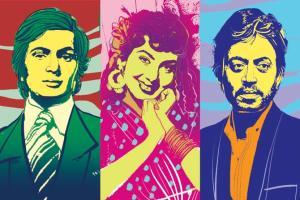Through cinema they straddled the cusp of worlds always changing, for better and worse simultaneously, just like us, helping us to flow with the flux

Illustration/Uday Mohite
![]() Why do movie stars matter so much to us? May be, because cinema amplifies and engages with not the timidities of rational logics, but the boldness of the senses. Its hyperkinetic tangle of conventions and innovations, speaks to our urges, desires, emotions and intellect, allows us to be all this and also several people at one time, fluid, unlike the rigid identities of law, society, political correctness. Movie stars communicate these libidinal energies of cinema through a bodily presence. Star and audience, mirror and remember each other, in an intimate, mysterious embrace.
Why do movie stars matter so much to us? May be, because cinema amplifies and engages with not the timidities of rational logics, but the boldness of the senses. Its hyperkinetic tangle of conventions and innovations, speaks to our urges, desires, emotions and intellect, allows us to be all this and also several people at one time, fluid, unlike the rigid identities of law, society, political correctness. Movie stars communicate these libidinal energies of cinema through a bodily presence. Star and audience, mirror and remember each other, in an intimate, mysterious embrace.
The three stars who died recently, each represented a specific era in this ongoing relationship.
Nimmi died in March, at 88. A major star of the studio era, she acted in India's first technicolour film (Aan, 1952). Often the feisty village belle, the unbound girl in the garden, she made heavy-lidded eye-contact with audiences in songs that yearn for love. Born Nawab Banoo, she was one of the last star-heroines from the tawaif communities. Practitioners of the sensual courtesanal arts—dance, music, poetry—tawaifs were erased from performing arts via colonial laws and rising nationalism, both squeamish about eroticism and pleasure. They transitioned to films, as producers, directors, actors, contributing to Bombay cinema's defining aesthetic—stylised eroticism through song, heightened emotive ada-kari, androgynous appeal, glimpsed in figures like Nighar Sultana and a focus on pleasuring the audience. With each filmic embrace we surrender to, each dance move we mimic, each song we sing, these aesthetics become part of us: a queer form of memory, bodily, but ephemeral.
Rishi Kapoor, who died at 67 last week, carried forward the sensuality through his dance and romance persona. His bodily vivacity fluidly merged masculine and feminine, past pleasures like qawwali and more contemporary pop enjoyments, even as parallel cinema's realism and masculine-centered Bachchan films began dominating. His beauty was delicate—androgynous pleasures—and he often paired with women whose attractiveness was more robust. Love was freedom, frolic, khullam khulla, yet luxuriously intimate, hum tum ek kamre mein.
Maintaining traditional cinema pleasures, he also replaced their stylised nature with a modern, casually stylish manner, pre-figuring later realist commercial film, into which he flowed with energetic ease, bridging two cinematic worlds.
Irrfan, who just passed away at 53, was an iconic figure in the post-globalisation emotional realist cinema with its cross-over films, less interested in symbolic storytelling, making room for more everyday characters. Some of this cinema believes in what I call aspirational realism, which considers older conventions of emotional and ornamental excess—like songs—as lesser. But, in fact, quite apart from his acting skills, what made Irrfan a star was the sexual intensity
of his presence—carrying forward that desi quality of emotional and sensual excess, something larger than life, yet intimate, to connect directly with the audience.
This is why I believe he was most compelling in films where he had a romantic track—Maqbool, Life In A Metro, Piku—and underserved by anaemic works like Lunchbox.
Critical culture sometimes favours a real estate mentality: location, yaniki cinema category, determines value and meaning. So it is, that too little has been said of Irrfan's cinematic, libidinal intensity, not enough about Rishi Kapoor's virtuosity. And barely anything about Nimmi. The artistes themselves defied categorisations.
Through cinema they straddled the cusp of worlds always changing, for better and worse simultaneously, just like us, helping us to flow with the flux.
Paromita Vohra is an award-winning Mumbai-based filmmaker, writer and curator working with fiction and non-fiction. Reach her at aromita.vohra@mid-day.com
Catch up on all the latest Mumbai news, crime news, current affairs, and a complete guide from food to things to do and events across Mumbai. Also download the new mid-day Android and iOS apps to get latest updates.
Mid-Day is now on Telegram. Click here to join our channel (@middayinfomedialtd) and stay updated with the latest news
 Subscribe today by clicking the link and stay updated with the latest news!" Click here!
Subscribe today by clicking the link and stay updated with the latest news!" Click here!









